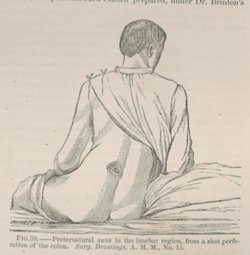Title: Marker, Allen J.
Source text: The Medical and Surgical History of the War of the Rebellion. (1861-65.), Part 2, Volume 2 (Washington, DC: Government Printing Office, 1876), 91.
Civil War Washington ID: med.d2e31629
TEI/XML: med.d2e31629.xml
CASE 276.—Private Allen J. Marker, Co. I, 4th Maine, aged 18 years, was wounded near Centreville, at the battle of Chantilly, September 1, 1862,¹ and was taken to the regimental hospital, where Surgeon G. W. Martin, 4th Maine, recorded his injury as a "gunshot wound of the side and arm." The wounded man was conveyed to Washington, and entered Epiphany Hospital on September 2d. Dr. N. P. Monroe states, without describing the wound of the arm, that "the ball passed through the left side between the ninth and tenth ribs, fracturing the latter, and lodged between the transverse processes of the third and fourth lumbar vertebræ, whence it was extracted, as I was informed, on the previous day." Surgeon J. H. Brinton, U. S. V., saw the patient, and notes the entrance wound as in the eight left intercostal space, and the lodgement as between the apophyses of the second and third lumbar vertebræ, and the ninth rib as fractured. The missile was placed in the Museum by Dr. Brinton, and is represented in the wood-cut (FIG. 58). The missile is said to have lain subcutaneously, and as soon as a counter-incision was made for its extraction, fæcal matter was discharged by this wound. From the anterior opening a number of bone splinters were extracted. A slight escape of fæcal matter from this opening lasted for fourteen days. From the preternatural anus in the loin a free discharge of fæces persisted for nearly seven months. On September 5th, a portion of sphacelated colon presented at the posterior orifice, and was removed with scissors by the ward surgeon. On September 10th, a piece of omentum, "twelve inches long and two inches wide" (sic), is said to have been removed. Notwithstanding the free suppuration from the wound in the arm and hypochondrium, the general condition of the patient was encouraging. He was sustained by a nourishing diet, with porter and tonic medicines. Late in October, Hospital Steward Stauch prepared, under Dr. Brinton’s supervision, an excellent water-color drawing of the subject. This is preserved in the Surgical Series of Drawings, A. M. M., as No. 15. A reduced copy of the drawing is presented in the accompanying wood-cut (FIG. 59). On November 1st, it is noted that the boy had a steady, hearty appetite, and maintained tolerable health, and that the dejections had taken place by the natural channel, on that day, for the first time since the reception of the injury. The lad was preparing to go to his home. On November 21st, though stercoraceous matter still escaped from the lumbar wound, the patient, at his own desire, was discharged from service by Surgeon James Bryan, U. S. V. The fæcal fistula persisted until May, 1863, when the discharge from the wounds became sero-purulent. A month afterward, both wounds healed up soundly, and the patient went to his home at Belfast, Maine. He was pensioned. On September 15, 1864, his condition was so satisfactory that his pension was reduced. He applied for an increase, and, on August 27, 1870, Pension Examiner Charles N. Germain, of Rockland, Maine, made the following report in the case: "A musket ball penetrated the lower third of the left arm, fracturing the humerus, as indicated by cicatrices and by irregularity of the surface of the bone. Arm weakened thereby, so that it is with difficulty he can raise more than thirty pounds. The natural dexterity of the arm is injured, and the hand weakened in its power of grasping. Disability one-half. Secondly, there exists a large depressed cicatrix on his left side, between the ninth and tenth ribs, where a musket ball entered; another large (two by four inches) callused cicatrix, between the third and fourth lumbar vertebræ, where a ball was cut out. In the wound of his side, a false passage existed for three or four months after receiving the wound, from which the excrements of his body escaped. The seat of the wound is now subject to periodical attacks soreness and pain. By reason of injury to the spine, his back is weak, and his side is slightly paralyzed. If he attempts to perform manual labor his back becomes so weak and lame that he cannot stand erect; his side also becomes weak and painful, producing general exhaustion. If he inclines forward his back becomes painful and weak; his bowels are constipated, requiring the constant use of purgatives; he is reduced in general strength; loss of weight, twenty-five pounds. For this disability, I rate him one-half; for both disabilities, total."
¹ See Annual Report of the Adjutant General of the State of Maine for the year 1862, p. 51, for particulars of the part the regiment bore in this engagement.

